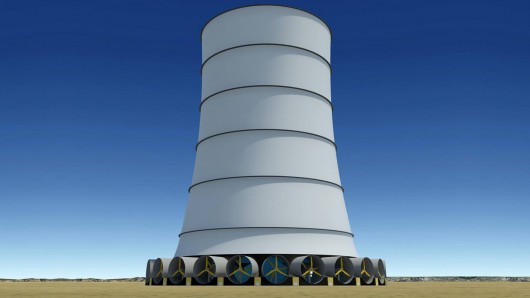Solar Wind Energy's Downdraft Tower generates its own wind all year round
By Darren Quick
June 18, 2014

Solar Wind Energy's Downdraft Tower generates its own wind that is directed down the hollow tower and through turbines placed around its base
When we think of wind power, we generally think of huge wind turbines sitting high atop towers where they can take advantage of the higher wind speeds. But Maryland-based Solar Wind Energy, Inc. is looking to turn wind power on its head with the Solar Wind Downdraft Tower, which places turbines at the base of a tower and generates its own wind to turn them.
Described by the company as the first hybrid solar-wind renewable energy technology in the renewable energy market, the tower at the center of the system generates a downdraft that drives the wind turbines positioned around its base. This is done by using a series of pumps to carry water to the top of a tower standing up to 2,250 ft (685 m) tall, where it is cast across the opening as a fine mist. The mist then evaporates and is absorbed by hot, dry air, thereby cooling the air and making it denser and heavier than the warmer air outside the tower.
This water-cooled air then falls through the hollow tower at speeds up to and in excess of 50 mph (80 km/h). When it reaches the bottom of the tower, the air is directed into wind tunnels that surround the base, turning wind turbines that are contained within the tunnels. Although the system requires large amounts of water, the bulk of the water emitted at the top of the tower is captured at the bottom and recirculated through the system, being pumped back up to the top with some of the power generated by the wind turbines.
In this way, the company claims the system can generate electricity 24 hours a day, 365 days a year, when located in a hot, dry area – although electricity generation would be reduced in winter. Depending on the tower's geographical location, electricity generation could also be supplemented through the use of vertical "wind vanes" that would capture the prevailing wind and channel it into the tower.
Solar Wind Energy says it has developed proprietary software capable of determining a tower's electricity generation capabilities based on the climate in geographic regions around the globe. Using the software, the company says it can predict the daily energy outputs of a tower based on its location and size.
Based on the most recent design specifications, the company says a tower designed for a site near San Luis, Arizona, would have a peak production capacity of up to 1,250 MWh on sunny days. However, when taking into account the lower generation capabilities during the winter months, the output for a year would average out to approximately 435 MWh.
The company points out that once built (using conventional materials, equipment and techniques), its towers are capable of operating throughout the year independent of wind speeds with virtually no carbon footprint, fuel consumption or waste generation.
Earlier this year, Solar Wind Energy gained the necessary local entitlements to pursue development of its first tower near San Luis, Arizona. The project got a leg up earlier this week when it announced a financing agreement with JDF Capital Inc., which will provide up to US$1,585,000 to the company. Solar Wind Energy says it is also exploring potential sites in Mexico, which along with the Middle East, Chile and India, would be an ideal location for the technology in terms of climate.
The video below explains how the Downdraft Tower works.
Source: Solar Wind Energy Inc.